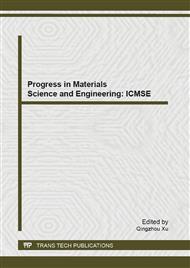[1]
Jiang, H.T., The causes of the red clay and the impact of it on the engineering properties. Hydrogeology and Engineering Geology, 3 (2000) 33-37.
Google Scholar
[2]
Zhao, Y.W., Kong, L.W., Guo, A.G., Tuo, Y.F., Mechanical behaviors and water-sensitive properties of intact Guangxi laterite. Chinese Rock and Soil Mechanics, 24(4) (2003) 568-572.
Google Scholar
[3]
Yang, Y.H., Bai, S.T., The influence of irreversibility of desiccation of lateritic soils on their physico-Mechanical Properties. Chinese Journal of Geotechnical Engineering, 4(4) (1982) 104-113.
Google Scholar
[4]
Wang, Y., Tang, L.S., Gao, Q.C., Liao, H.R., Effects of water-soil interaction on mechanical strength of residual red clay. Acta Scientiarum Naturalium Universitatis Sunyatsen I, 46(1) (2007) 128-132.
Google Scholar
[5]
Wang, Z.W., HONG, B.N., LIU, X., ZHOU, Q., Water-sensitive properties of shear strength of red clay. Journal of Sichuan University (Engineering Science Edition), 43(1) (2011) 17-22.
Google Scholar
[6]
Lu, N., W. J. Likos, Unsaturated Soil Mechanics, John Wiley, New York., (2004).
Google Scholar
[7]
van Genuchten, M.T., A closed-form equation for predicting the hydraulic conductivity of unsaturated soils. Soil Science Society of America Journal, 44(5) (1980) 892-898.
DOI: 10.2136/sssaj1980.03615995004400050002x
Google Scholar
[8]
Perrier, E., et al., Models of the water retention curve for soils with a fractal pore size distribution. Water Resources Research, 32(10) (1996) 3025-3031.
DOI: 10.1029/96wr01779
Google Scholar
[9]
Topp, G.C., A. Klute, and D.B. Peters, Comparison of water content-pressure head data obtained by equilibrium steady-state and unsteady-state methods. Soil Science Society of America Proceedings, 31(3) (1967) 312-314.
DOI: 10.2136/sssaj1967.03615995003100030009x
Google Scholar
[10]
Smiles, D., G. Vachaud and M. Vaulin, A test of the uniqueness of the soil moisture characteristic during transient, nonhysteretic flow of water in a rigid soil. Soil Sci. Soc. Am. Proc., 35 (1971) 534-539.
DOI: 10.2136/sssaj1971.03615995003500040018x
Google Scholar
[11]
Vachaud, G., M. Vauclin, and M. Wakil, A study of the uniqueness of the soil moisture characteristic during desorption by vertical drainage. Soil Sci. Soc. Am. Proc., 36(3) (1972) 531-532.
DOI: 10.2136/sssaj1972.03615995003600030044x
Google Scholar
[12]
Hollenbeck, K.J. and K.H. Jensen, Experimental evidence of randomness and nonuniqueness in unsaturated outflow experiments designed for hydraulic parameter estimation. Water Resources Research, 34(4) (1998) 595-602.
DOI: 10.1029/97wr03609
Google Scholar
[13]
Wildenschild, D., J.W. Hopmans, and J. Simunek, Flow rate dependence of soil hydraulic characteristics. Soil Science Society of America Journal, 65(1) (2001) 35-48.
DOI: 10.2136/sssaj2001.65135x
Google Scholar
[14]
Wayllace, A., Lu, N., A transient water release and imbibitions method for rapidly measuring wetting and drying soil water retention and hydraulic conductivity functions. Geotechnical Testing Journal 35(1) (2012) 1-15.
DOI: 10.1520/gtj103596
Google Scholar
[15]
Hwang, S.I. and S.E. Powers, Estimating unique soil hydraulic parameters for sandy media from multi-step outflow experiments. Advances in Water Resources, 26(4) (2003) 445-456.
DOI: 10.1016/s0309-1708(02)00107-0
Google Scholar
[16]
Chen, H., Wei, C.F., Cao, H.F., Wu, E.L., Li, H., Dynamic capillary effect and its impact on the residual water content in unsaturated soils. GeoFlorida 2010: Advances in Analysis, Modeling & Design, 329-337, (2010).
DOI: 10.1061/41095(365)30
Google Scholar
[17]
Yi, P.P., Rapid determination of hydraulic properties of unsaturated soils -theory and methodology. PH.D.: Institute of Rock & Soil Mechanics Chinese Academy of Science, P.R., China, (2011).
Google Scholar


